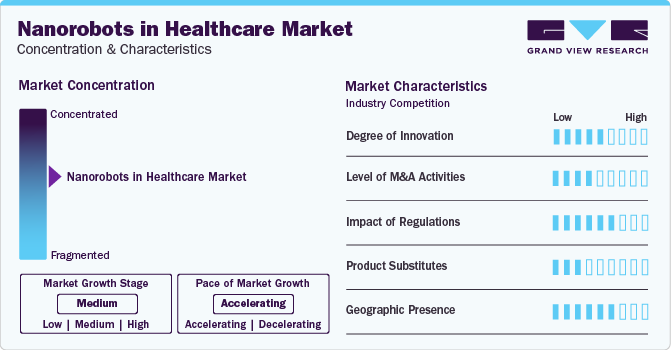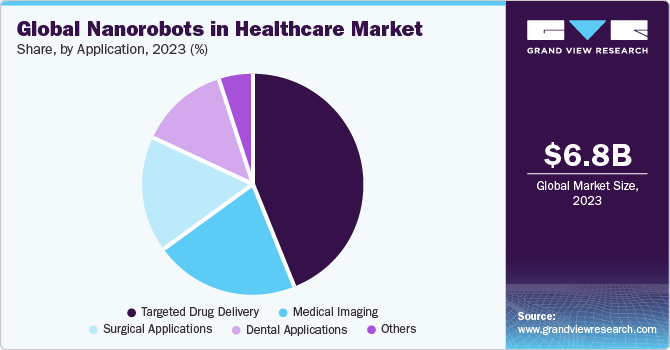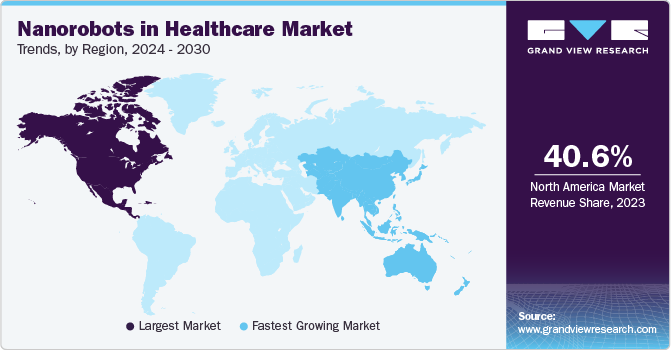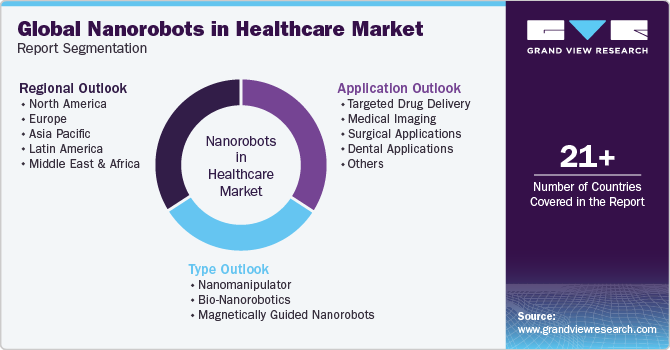- Home
- »
- Healthcare IT
- »
-
Nanorobots In Healthcare Market Size & Share Report, 2030GVR Report cover
![Nanorobots In Healthcare Market Size, Share & Trends Report]()
Nanorobots In Healthcare Market Size, Share & Trends Analysis Report By Type (Nanomanipulator, Bio-Nanorobotics, Magnetically Guided Nanorobots), By Application, By Region, And Segment Forecasts, 2024 - 2030
- Report ID: GVR-4-68040-302-2
- Number of Report Pages: 150
- Format: PDF, Horizon Databook
- Historical Range: 2018 - 2023
- Forecast Period: 2024 - 2030
- Industry: Healthcare
Nanorobots In Healthcare Market Trends
The global nanorobots in healthcare market size was estimated at USD 6.80 billion in 2023 and is projected to grow at a CAGR of 6.1% from 2024 to 2030. The increasing need for precise drug delivery in cancer treatment is driving the growth of the market. Conventional chemotherapy and radiation therapies often impact both cancerous and healthy cells, resulting in severe side effects and reducing the quality of life for patients. Nanorobots enhance treatment efficiency by carrying out advanced biomedical therapies through minimally invasive procedures. According to a 2023 ScienceDirect report, nanorobots can identify 12 different types of cancer cells.

The increasing prevalence of cancer worldwide is also driving market growth. As per the American Society of Clinical Oncology (ASCO) report, in 2023, an estimated 82,290 adults (62,420 men and 19,870 women) in the U.S. were diagnosed with bladder cancer. Globally, about 573,278 people were diagnosed with bladder cancer in 2020. This rising prevalence of cancer is leading to an increased demand for precise treatment, resulting in a higher number of clinical trials seeking new, advanced treatments. For instance, as per a study published in the journal Nature Nanotechnology, researchers led by teams at the CIC biomaGUNE and Institute for Bioengineering of Catalonia (IBEC), demonstrated the effectiveness of a one-time administration of urea-fueled nanorobots carrying radionuclides in reducing the bladder tumors size in mice by 90%. Such an increasing number of studies indicating the benefits of nanorobots is boosting market growth.
Increasing funding from government and non-government bodies for the development of nanorobotics is also driving market growth. In September 2023, Nanobots Therapeutics, a startup specializing in developing biocompatible nanorobots for more efficient and safer drug delivery to challenging tumors, completed a Pre-Seed funding round of USD 519,529. The startup intends to concentrate on the advancement and commercialization of the MotionTx technological platform, which exploits the potential of nanorobots to penetrate tissues and transport drugs directly to cancer cells. Such increasing adoption of nanorobots in cancer treatment will supplement market growth.
Furthermore, nanorobotics offers promising advancements in the development of minimally invasive surgical techniques. Nanorobots can be designed to perform complex surgical tasks at the microscopic level, such as repairing damaged tissues or removing obstructions in blood vessels. This capability reduces the need for large surgical incisions, thereby decreasing recovery times and lowering the risk of complications. For instance, researchers are exploring the use of nanorobots to clear arterial blockages that cause heart attacks. These nanorobots can break down plaques within arteries, offering a less invasive and more precise treatment. In April 2024, a research team with expertise in various fields at the Chinese University of Hong Kong (CUHK) created nanorobots anchored with magnetic tissue plasminogen activators (tPA-nbots) to address ischemic stroke. This innovative technology has been shown to dissolve blood clots 5 to 20 times faster than conventional treatments and can reopen smaller and more distant blood vessels. It can reduce brain damage and minimize side effects, offering promising benefits to patients. Such increasing applications of nanorobots are fostering market growth.
Market Concentration & Characteristics
The latest R&Ds are investigating the capabilities of nanorobots to travel through the bloodstream, identify and repair damaged tissues, and even carry out intricate cellular repairs. The rapid advancements in materials science, molecular biology, and computational modeling are speeding up the innovation process, establishing nanorobotics as a fundamental aspect of future healthcare solutions. This technology has the potential to greatly enhance outcomes and broaden the scope of personalized medicine

The market is characterized by a moderate level of merger and acquisition (M&A) activities by leading players due to factors, including high business expansion activities to cater to the growing demand for nanorobots. Furthermore, increasing R&D activities support market growth. In August 2022, scientists developed nanorobots using electron beam lithography, which is compatible with immune cells. This advancement in nanorobots is expected to increase its demand
The regulatory landscape of the market is complex and constantly changing. This reflects the advanced nature of the technology and its potential impact on medical practices. Regulatory bodies, such as the FDA in the U.S., the European Medicines Agency in Europe, and other national health agencies, play vital roles in ensuring the safety, effectiveness, and ethical deployment of nanorobotic technologies
Microelectromechanical systems (MEMS) offer precise diagnostic and therapeutic functions, bridging the gap between traditional macroscale medical devices and nanoscale capabilities. In addition, biocompatible drug delivery systems, such as liposomes and polymer-based nanoparticles, effectively target and release therapeutic agents within the body, mimicking some benefits of nanorobotics without the need for complex machinery
Several market players are expanding their business by entering new geographical regions to strengthen their market position and expand product portfolios. Rising research and development activities create more opportunities for market players to enter new regions
Type Insights
In 2023, the nanomanipulator segment dominated the market and accounted for the largest revenue share of 76.1%. Nanomanipulators are advanced tools that allow for precise manipulation of nanoscale materials and structures. The high-resolution imaging and manipulation capabilities provided by electron microscopes and scanning probe microscopes are crucial for advancing nanorobotic applications in healthcare. In addition, the increasing use of nanomanipulators in the research and development (R&D) of microchips and microbiological systems is driving the market growth. Furthermore, increasing the availability of electron microscopes will supplement the segment growth.
The bio-nanorobotics segment is anticipated to witness the fastest growth over the forecast period. Increasing R&D activities in the field of bio-nanorobotics are fostering market growth. For instance, in December 2023, researchers at universities in New York and Ningbo, China, developed small robots using DNA. These 3D DNA nanorobots could replicate themselves and can be utilized for precise drug delivery by navigating through a patient's bloodstream to locate cancer cells, eliminating the need for invasive procedures. Such technological advancement in bio-nanorobotics is expected to boost market growth.
Application Insights
The targeted drug delivery segment held the largest revenue share of 44.0% in 2023. Nanorobots are tiny intelligent devices capable of converting internal energy or external physical stimuli into mechanical force to produce independent movement. Nanorobots are primarily used for targeted drug delivery as they can autonomously navigate through the human body using different propulsion methods to reach diseased areas that are challenging to access with traditional delivery techniques. Among these devices, chemically/biochemically propelled nanorobots show great potential for applications in treating gastrointestinal (GI) inflammation in vivo due to their use of biocompatible endogenous fuels.

For instance, in February 2023, as per the American Association for the Advancement of Science (AAAS) report, a research team developed a twin-bioengine yeast nanorobot for gastrointestinal (GI) inflammation therapy. The medical imaging segment is anticipated to register significant growth over the forecast period. Medical imaging is vital for visualizing anatomical structures and physiological processes. When used with nanorobots, it allows real-time visualization and tracking of nanorobotic agents, enhancing their effectiveness in healthcare. Nanorobots improve medical imaging by reaching deep tissues and providing strong penetration, resulting in clearer images. In addition, increasing demand for early and accurate disease detection is fueling segment growth.
Regional Insights
North America nanorobots in healthcare market held the largest revenue share of 40.6% in 2023 owing to the robust research infrastructure, technological innovation, and strong investment in biomedical research. Furthermore, the presence of well-established market players and high healthcare expenditure in North America creates a conducive environment for the adoption of advanced medical technologies, including nanorobots.

U.S. Nanorobots In Healthcare Market Trends
The nanorobots in healthcare market in the U.S. held the largest share of 87.0% of the North America market revenue in 2023. Researchers are involved in the innovation of nanorobot technology to boost its adoption. For instance, in June 2021, a team of U.S. researchers at the University of Colorado Boulder potentially identified the ideal foundation for manufacturing the next generation of nanorobot technology. These novel particles, called nanoswimmers, possess characteristics that make them highly versatile and suitable for a variety of applications.
Canada Nanorobots In Healthcare Market Trends
Canada nanorobots in healthcare market is anticipated to register the fastest growth during the forecast period. Increasing adoption of strategic initiatives is one of the major factors driving market growth. In April 2023, the University of Toronto Robotics Institute collaborated with the Hospital for Sick Children (SickKids) to create an innovative treatment for glioblastoma (GBM) patients. Professor Yu Sun and his team are utilizing nanorobotics, a field focused on developing minuscule robots, to construct a potential novel treatment: "nano-scalpels" designed to locate and eliminate cancer cells by spinning when activated by a magnetic field.
Europe Nanorobots In Healthcare Market Trends
The nanorobots in healthcare market in Europe is anticipated to register significant growth during the forecast period owing to the increasing awareness regarding the benefits of nanorobots in surgeries. Moreover, increasing funding for nanorobotics will escalate market growth. In May 2018, Marie Skłodowska-Curie Actions funded a new consortium led by Professor Kurt Gothelf at the Interdisciplinary Nanoscience Center with USD 4.3 million. The consortium aimed to pave the way for the creation of DNA-based robots through the training of 15 PhD students.
Germany nanorobots in healthcare market is anticipated to register a considerable growth rate during the forecast period. Growing support from government bodies and increasing investment in nanorobotics are driving the market growth. Moreover, rising application areas of microscopes are further supplementing the demand for nanorobots.
The nanorobots in healthcare market in the UK is anticipated to register a considerable growth rate during the forecast period. The increasing number of product launches and approvals in the country is driving market growth. For instance, In September 2023, Nanovery, a deep-tech startup, was awarded a patent for its groundbreaking DNA nanorobot platform, which aims to facilitate uncomplicated diagnostic tests for diseases and propel drug development forward.
Asia Pacific Nanorobots In Healthcare Market Trends
Asia Pacific nanorobots in healthcare market is anticipated to register the fastest growth rate during the forecast period owing to rapid technological advancements, growing healthcare infrastructure, and increasing investment in research and development. Furthermore, the rising prevalence of chronic diseases, aging populations, and unmet healthcare needs, create opportunities for innovative solutions such as nanorobotic-based therapies.
The nanorobots in healthcare market in China held the largest share of the APAC regional market in 2023. The country's rapidly increasing demand for robotic-assisted surgery and rising government support for innovation will drive the market growth. Furthermore, increasing investment in nanotechnology will boost market growth. The strong commitment of the Chinese government to support the field of nanoscience and nanotechnology is a key advantage for China in competing with leading forces such as the U.S., Europe, Japan, and Russia. Nanoscience and nanotechnology have been recognized as a key industry in China's 13th Five-Year Plan, signaling continued government funding and support for research and development in this field. This commitment aligns with the 'Made in China 2025' initiative, which seeks to elevate China into a leading high-tech manufacturing hub by providing legislative and regulatory backing for nanotechnology advancements.
India nanorobots in healthcare market is anticipated to register considerable growth during the forecast period. Increasing research in the field of robotics will contribute to market growth. In December 2021, the Maharashtra Institute of Medical Education and Research (MIMER) in Pune created a nano robot, designed to capture and separate circulating tumor cells. This innovation is anticipated to pave the way for a faster and more precise cancer diagnostic approach.
Latin America Nanorobots In Healthcare Market Trends
The nanorobots in healthcare market in Latin America is anticipated to register lucrative growth during the forecast period due to the high adoption of nanotechnology. In April 2024, Brazil achieved a notable advancement in the nanotechnology sector by embracing a globally acknowledged industrial norm for graphene. This norm, created in partnership with more than 30 nations within ISO/TC 229 - Nanotechnologies, is designed to define the properties of graphene and its diverse applications, thereby facilitating the advancement of innovative technologies.
MEA Nanorobots in Healthcare Market Trends
MEA nanorobots in healthcare market is anticipated to register considerable growth during the forecast period. The evolving healthcare landscape and growing demand for advanced medical technologies are projected to boost market growth. Moreover, increasing disease burden is expected to contribute to market growth.
Key Nanorobots In Healthcare Company Insights
Key participants in the nanorobots in healthcare market are focusing on devising innovative business growth strategies in the form of product portfolio expansions, partnerships & collaborations, mergers & acquisitions, and business footprint expansions. Some of the key players operating in the market include Bruker, Ginkgo Bioworks, JEOL Ltd., Klocke Nanotechnik GmbH, Kleindiek Nanotechnik GmbH, SmarAct GmbH, and Nanonics Imaging Ltd.
Key Nanorobots In Healthcare Companies:
The following are the leading companies in the nanorobots in healthcare market. These companies collectively hold the largest market share and dictate industry trends.
- Bruker
- Ginkgo Bioworks
- JEOL Ltd.
- Klocke Nanotechnik GmbH
- Kleindiek Nanotechnik GmbH
- SmarAct GmbH
- Nanonics Imaging Ltd.
- Hummingbird Scientific
- DNA Nanobots, LLC
- Creative Biolabs
- Theranautilus
Recent Developments
-
In January 2024, DNA Nanobots, a leading company in designing and delivering DNA nanoparticles for targeted therapeutics, announced the successful closure of its pre-seed funding round. This investment will enable DNA Nanobots to launch its BioPharma Partner Program, aimed at streamlining the process of creating custom biopharma solutions from design to development for preclinical and animal studies. Ultimately, this will enhance the delivery of a wide range of therapeutics
-
In February 2023, Nanobots Therapeutics, a spin-off launched by IBEC and ICREA, aimed to develop a technology utilizing nanorobots with exceptional tumor penetration capabilities
-
In June 2018, Bruker acquired JPK Instruments AG (JPK) to expand its life science microscopy portfolio and add mechano-biology measurements
Nanorobots In Healthcare Market Report Scope
Report Attribute
Details
Market size value in 2024
USD 7.46 billion
Revenue forecast in 2030
USD 10.64 billion
Growth rate
CAGR of 6.1% from 2024 to 2030
Actual data
2018 - 2023
Forecast data
2024 - 2030
Quantitative units
Revenue in USD million/billion and CAGR from 2024 to 2030
Report coverage
Revenue forecast, company ranking, competitive landscape, growth factors, and trends
Segments covered
Type, application, region
Regional scope
North America; Europe; Asia Pacific; Latin America; MEA
Country scope
U.S.; Canada; Mexico; Germany; UK; Spain; Italy; France; Norway; Denmark; Sweden; Japan; China; India; Australia; Thailand; South Korea; Brazil; Argentina; South Africa; Saudi Arabia; UAE; Kuwait
Key companies profiled
Bruker; Ginkgo Bioworks; JEOL Ltd.; Klocke Nanotechnik GmbH; Kleindiek Nanotechnik GmbH; SmarAct GmbH; Nanonics Imaging Ltd.; Hummingbird Scientific; DNA Nanobots, LLC; Creative Biolabs; Theranautilus
Customization scope
Free report customization (equivalent up to 8 analysts working days) with purchase. Addition or alteration to country, regional & segment scope
Pricing and purchase options
Avail customized purchase options to meet your exact research needs. Explore purchase options
Global Nanorobots In Healthcare Market Report Segmentation
This report forecasts revenue growth at global, regional, and country levels and provides an analysis of the latest trends in each of the sub-segments from 2018 to 2030. For this study, Grand View Research, Inc. has segmented the nanorobots in healthcare market report on the basis of type, application, and region:

-
Type Outlook (Revenue USD Million, 2018 - 2030)
-
Nanomanipulator
-
Electron Microscope
-
Scanning probe microscope
-
-
Bio-Nanorobotics
-
Magnetically Guided Nanorobots
-
-
Application Outlook (Revenue USD Million, 2018 - 2030)
-
Targeted Drug Delivery
-
Medical Imaging
-
Surgical Applications
-
Dental Applications
-
Others
-
-
Regional Outlook Revenue USD Million, 2018 - 2030)
-
North America
-
U.S.
-
Canada
-
Mexico
-
-
Europe
-
Germany
-
UK
-
Spain
-
Italy
-
France
-
Denmark
-
Norway
-
Sweden
-
-
Asia Pacific
-
Japan
-
China
-
India
-
Australia
-
Thailand
-
South Korea
-
-
Latin America
-
Brazil
-
Argentina
-
-
MEA
-
South Africa
-
Saudi Arabia
-
UAE
-
Kuwait
-
-
Share this report with your colleague or friend.
![gvr icn]()
NEED A CUSTOM REPORT?
We can customize every report - free of charge - including purchasing stand-alone sections or country-level reports, as well as offer affordable discounts for start-ups & universities. Contact us now
![Certified Icon]()
We are GDPR and CCPA compliant! Your transaction & personal information is safe and secure. For more details, please read our privacy policy.
We are committed towards customer satisfaction, and quality service.
"The quality of research they have done for us has been excellent."





